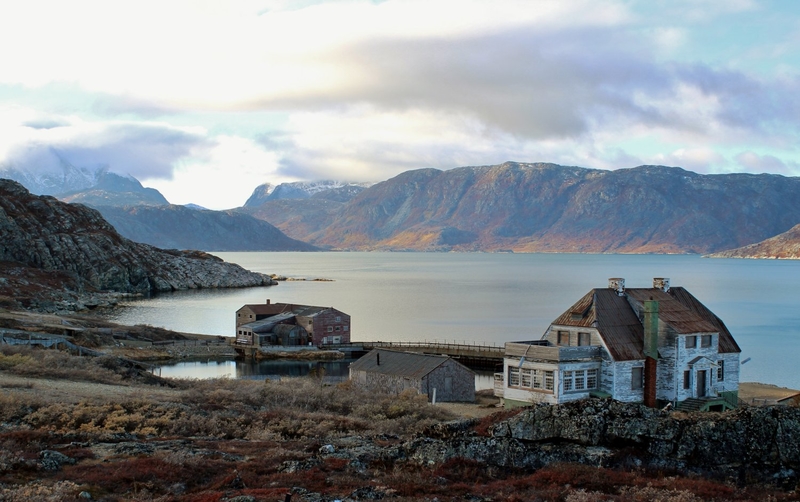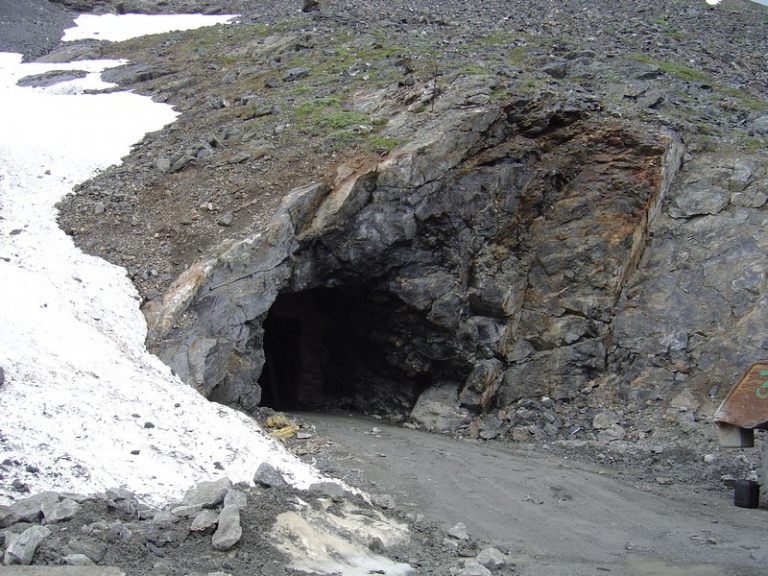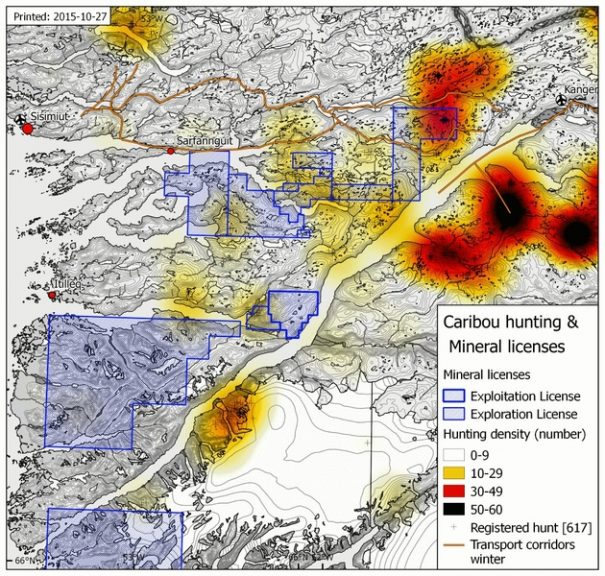Environment and Mineral Resources
The Department of Environment and Mineral Resources advise the Government of Greenland on environmental issues related to mineral resources. This includes consultancy related to exploration and exploitation of minerals and offshore activities related to oil and gas exploration.

The abandoned cryolite mine at Ivittuut, from where the Arsuk Fjord is affected with heavy metals. Photo: M. Birch Larsen.
Minerals
The Greenland subsoil contains a variety of valuable minerals, rare earth metals, precious metals, precious stones, coal, graphite and uranium. Greenland has been a mining nation since the late 1700’s, where coal was excavated in Qaarsut on the Nuussauq Peninsula.
In addition to coal, a mining has included gold, silver, copper, lead, zinc, graphite, olivine, cryolite and marble.
A number of mines have closed in recent years, including the Seqi olivine mine near Maniitsoq, which was shut down in 2011, and the Nalunaq gold mine near Nanortalik, which was decommissioned in 2013.
However, new mining projects have been launched, including a ruby mine near Qeqertarsuatsiaat (Fiskenæsset). An application is expected to be filed for a mine to exploit rare earth elements and uranium at Kuannersuit (Kvanefjeld).
A current list of assigned exploration and exploitation licenses can be found on the Greenland Self-Government website www.govmin.gl/minerals.
The role of the department is to advise the responsible authority – the Environmental Agency for Mineral Resources Activities – in issues concerning possible environmental impacts associated with mining activities. The advice is related to the issuing of exploration and exploitation permit licenses, approval of fieldwork, EIA’s (Environmental Impact Assessment) and monitoring in connection to construction, operation and decommissioning of mines.

The entrance to the former goldmine in Nalunaq. Photo: Yu Jia
Oil and gas
Assessments suggest there is a huge potential for oil exploitation in the waters off Greenland. To gain a better insight into the geological conditions, international oil companies employ seismic surveys and exploratory drilling within their assigned offshore license areas. Similar investigations are also underway on land (onshore), for example, on the Nuussuaq Peninsula, where the discovery of oil seeps in the nineties sparked an interest for further studies.
A current list of assigned oil exploration and exploitation licenses can be found on the Government of Greenland’s website www.govmin.gl/petroleum.
The department advises the Government of Greenland on the environmental impact associated with onshore and offshore oil activities.
Uranium
In October 2013, the Parliament of Greenland, Inatsisartut, officially changed its mining policy and opened up for extraction of uranium and other radioactive minerals in Greenland. This means that mining companies can now submit applications to exploit radioactive minerals in Greenland’s subsoil.
The Greenland Institute of Natural Resources (GINR) and the Danish Centre for Environment and Energy (DCE) at Aarhus University have reached an agreement with the Environment Agency for Mineral Resources Activities on building expertise and disseminating information on the environmental impact and regulation of uranium exploitation in Greenland. The agreement includes a review of environmental problems that uranium extraction has caused in other countries, and how these countries have tackled the problems that have arisen. The review focuses particularly on the US, Canada and Australia, which have large mining industries and extensive experience in both legislation and environmental problems.
GINR and DCE are in the process of elaborating a comprehensive report with a detailed assessment of the entire process surrounding the extraction of radioactive materials, environmental problems and solutions, legislation and regulation. The title of the report is: Environmental Issues and Management of Exploitation of Naturally Occurring Radioactive Minerals in Greenland. The report will only be available in English, but with a summary in Danish and Greenlandic.
Furthermore, the two organizations have compiled a brief pamphlet aimed at providing an overview of the environmental problems that the extraction of radioactive materials can entail, and how these problems can be prevented or minimized. This paper is expected to be published during the course of 2016.

Rock sample from Kvanefjeld with arfvedsonite (black), eudialyte (red), feldspar and sodalite (white). Photo: O. Geertz-Hansen
Data centre
The Danish Centre for Environment and Energy (DCE) and the Greenland Institute of Natural Resources (GINR) maintain an interdisciplinary data centre on the environment in Greenland. The centre stores, quality-assures and harmonizes data collected by the two organizations and by owners of licenses to conduct exploration for oil and mineral resources. This makes key data available to DCE, GINR, license owners and government agencies who use this information to compile reports and conduct research projects. We invite you to contact DCE or GINR concerning the use of data.
See more on the DCE’s website.

Example of a map with areas for caribou hunting, including activities related to land-based transport, mineral prospecting and mining in the Kangerlussuaq Fjord area, West Greenland.
Agriculture in Greenland
Read the Synthesis Report “Agriculture in Greenland – possibilities and needs for future development and research for Greenland” by Agricultural Initiative (GRAIN) in cooperation with Greenland Perspective.

